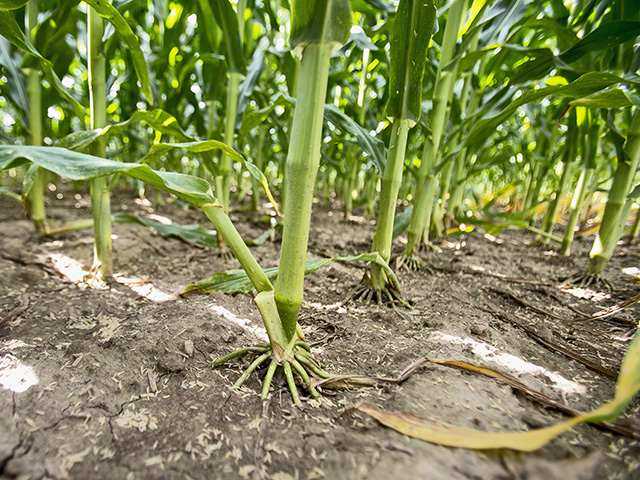Seed Counts
Conquer Your Corn Costs - Seed Counts
John Verell III is a corn-yield champion, but pushing seeding rates is not part of his winning strategy on his farm, near Jackson, Tennessee.
In 2019, a yield of 320.8 bushels per acre (bpa) earned him first place in Tennessee for no-till, nonirrigated corn in the National Corn Growers Association National Corn Yield Contest. Pioneer P1197YHR, with a harvest count of 34,000 stalks per acre, gave him his winning entry. His seeding rate was 34,600 per acre.
Verell earned that honor, in part, by following the seed company's recommended seed rate for optimum economic return. He tends to stick to recommended rates on all his 4,200 acres.
"I always thought you could push yields with higher populations, but I have since realized there are usually other limiting factors," Verell explains. "The biggest thing is the right hybrid in the right place with limited fertilizer at planting, sidedress and then spoon-feed throughout the season based on weekly tissue sampling."
Verell's planting rates range from 26,000 to 38,000 seeds per acre, depending on the hybrid and soil. With data from nearly 20 years of grid-sampling on a three-year rotation, yield maps and imagery, he knows his fields and what they will do. Weaker dryland ground gets a hybrid that can flex with growing conditions and a lower seeding rate. Better soils under irrigation get high-yielding hybrids and higher seed populations.
PLANTING-RATE RESEARCH
Planting-rate studies at the University of Kentucky (UK), conducted in 2017 to 2018, suggest that agronomic and economic performance will vary, even under the best growing conditions and soils.
P[L1] D[0x0] M[300x250] OOP[F] ADUNIT[] T[]
While under irrigation, high-performing hybrids topped out agronomically at 50,000 seeds per acre. Optimum economic population was achieved at 42,000 to 44,000 seeds, with consistent yields of 280 to 320 bpa.
"At 50,000, you may get 5 to 10 bushels more, but that is inconsistent, and the additional seed doesn't pay for itself," says Chad Lee, UK Extension professor and Grain and Forage Center of Excellence director. "Even with prices where they are, 42,000 to 44,000 seeds per acre under irrigation made us money."
BRAGGING RIGHTS OR MONEY
When it comes to pushing seeding rates, Steve Gauck, Beck's Hybrids regional agronomy manager, suggests growers ask themselves two questions: Do you want to go to the coffee shop and brag about the highest yield? Or, do you want to drive a new pickup truck to the coffee shop because you made the most money?
Gauck acknowledges seed company recommendations are sometimes seen as suspect, as they are in the business to sell seed. The reality, he explains, is that Beck's recommended rate curves are based on the company's own agronomic experience. This is influenced by planting conditions and planter setup experience gathered by Beck's Practical Farm Research cooperators.
"As hybrids mature, we are able to fine-tune recommendations based on different weather patterns, soil types, planting dates, fertility and more, averaging all of those back into the economic seed-planting rate curve," Gauck says.
He cautions that when a hybrid outperforms at the optimum rate, that doesn't mean a higher rate is justified. "One year, we had a lower population hybrid that was one of our highest-yielding numbers," Gauck recalls. "The next year, customers wanted to plant it at a higher population. We knew from our research that the yields would go down. We could have sold more seed, but we recommended against higher planting rates."
Gauck encourages corn producers who seek a better understanding of seeding rates to do their own on-farm research. When evaluating data from other sources, he advises farmers to consider weather patterns, planting conditions and plot fertility, as well as yields. It is all data Lee would like seed companies to make available.
"For the most part, they tend to share results from deeper soils with higher productivity and with lower risk of drought stress," he says. "I think it would be phenomenal if they shared soil types and field conditions as well as yield. I would love to see that data on a broader scale. While the most productive acres may be in the I-states, there are a whole lot more corn acres outside of that region."
PEACE OF MIND
Getting access to more data is one reason Cale Carlson joined Farmers Business Network (FBN). The organization shares aggregated data from 39 million acres, or 260 million acres when including multiple years of data. Using the FBN dashboard, the Marquette, Nebraska, farmer can search out hybrids he is interested in cross-referenced against soil types, growing conditions and management styles similar to his own.
"I follow my seed company recommendations, but it is nice to double-check them against the aggregated data from other farmers," he says.
Matt Meisner, head of FBN's Data Analytics, indicates seed-company recommendations may be a little high. "Our aggregated data suggest our members are finding similar yields while reducing populations by 5 to 10%.
FBN data shows 30 to 35% of fields are planted at a seeding density that could have been lower without economic harm.
"With seed costs well over $100 an acre not uncommon, saving 10% can be important to the bottom line," Meisner says.
Carlson runs his own comparisons of seeding rates, as well as various products and practices, adding his 2,000 irrigated acres of seed, white and yellow corn, to the FBN data. "We want to see if they pay in our operation," he says. "Combining our data with FBN data can give me the added confidence to move forward in the extreme planting conditions we have faced in recent years."
[PF_0920]
(c) Copyright 2020 DTN, LLC. All rights reserved.




